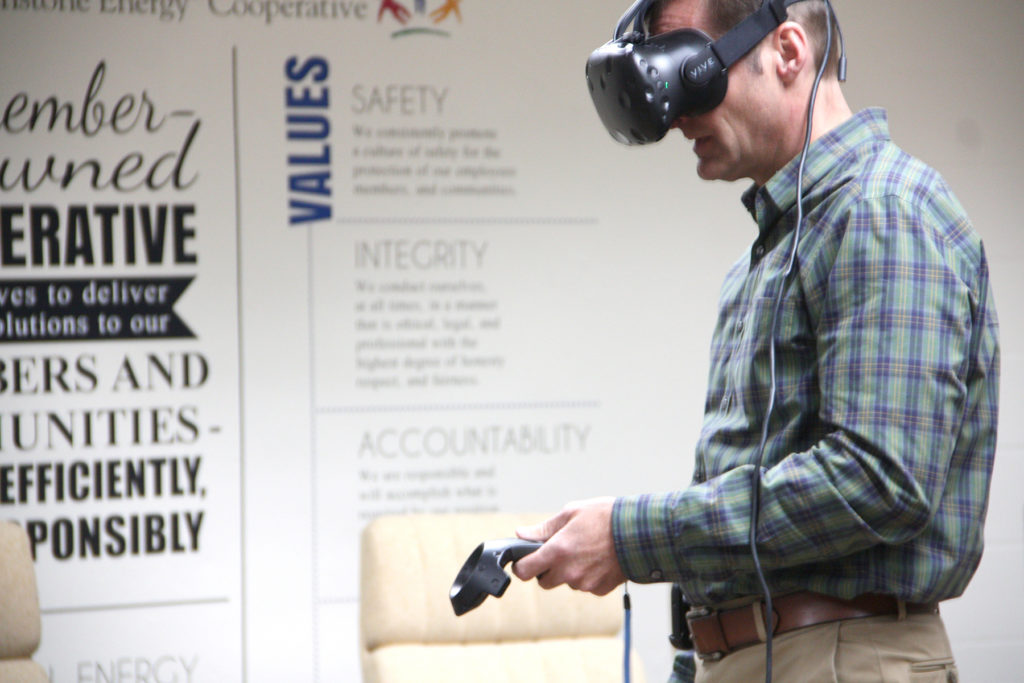
When Jo-Carroll Energy acquired the Illinois assets of Alliant Energy more than 10 years ago, it faced an immediate challenge: how to get a handle on the 16 additional substations that came as part of the deal, when no blueprints existed.
Before the Elizabeth, Illinois, electric cooperative teamed up with a Dubuque, Iowa, company on a solution involving 3D digital scans and virtual reality technology, training was an onerous task, with the substations 25 to 70 miles away from co-op headquarters.
“We had a different style of construction on those substations versus our traditional substations. They weren’t completely different but different enough that the lack of detailed documentation was a concern,” said Dean Skinner, manager of engineering services at Jo-Carroll Energy.
Today, engineers at JCE and its power suppliers, Dairyland Power Cooperative and Prairie Power, can access highly detailed, accurate scans of 18 of the co-op’s 34 substations without leaving their offices.
“Engineers can visit a substation virtually to take measurements and view equipment, saving time and resources,” said Mike Casper, JCE’s president and CEO.
The co-op and the company “knowledgeable of all things VR” have been working on the project for several years, said Skinner. Early scans generated “3D point clouds,” vague collections of dots “where you kind of got an idea of the shape but in a congested area where there’s lots of equipment, you could never really determine if you were looking at one piece of equipment or another,” said Skinner.
But thanks to advances in digital technology, a more sophisticated scanner can snap full-color, panoramic images of each substation and merge them with the point clouds.
“Putting those two technologies together really made a very powerful combination,” said Skinner. He added that the co-op learned from the vendor how to do its own scans and rents equipment, which keeps costs low.
Outside consultants unfamiliar with the co-op and working on system upgrades especially appreciate the scans. “We’re adding $1 million worth of equipment to one of the substations [40 minutes away] and we need to confirm how it’s built now and where we can add stuff,” Skinner said. “Just the travel savings alone on that project versus having engineers onsite has saved at least a dozen trips.”
Encouraged by that project’s success, the co-op is exploring immersive VR trainings on one of the scanned substations. In a recent demonstration at the co-op’s headquarters, 20 employees, wearing headsets, remotely opened and closed an electronic recloser and retrieved critical data from a remote substation.
“We placed sensors in the room to define the boundaries of the substation’s control room,” said Skinner. “Four people can train at the same time in one room, and other staff in the room were spotters to keep [testers] from tripping over actual cords in the room or running into real walls.”
While workers embraced the technology, it’s not a part of everyday training. The full immersion component is still in its infancy and requires more customized programming, an exacting, exhaustive and expensive process. “As we got into it, we realized we need a lot more partners involved to develop a library that we can all share,” said Skinner.
Still, VR has a lot of potential as a training tool because it can shorten the learning curve on new tasks, keep workers fresh on certain skills and provide a safe learning environment, said Casper.
“VR can help us train new workers and educate other employees without exposing them to high-voltage electric hazards,” he said. “Training can be done without driving to the location and on bad weather days, saving time and increasing productivity.
Skinner added that the scans are good building blocks for future projects, too.
“No matter what the path is, you start with your scans. If you’re just going to use it for engineering purposes, VR or augmented reality, great,” he said. “You still have that base data from the scans. Even if step one is scan the substations, you won’t lose any value going forward.”
Check out the NRECA case study on cooperative.com about JCE’s VR project.
Victoria A. Rocha is a staff writer at NRECA.